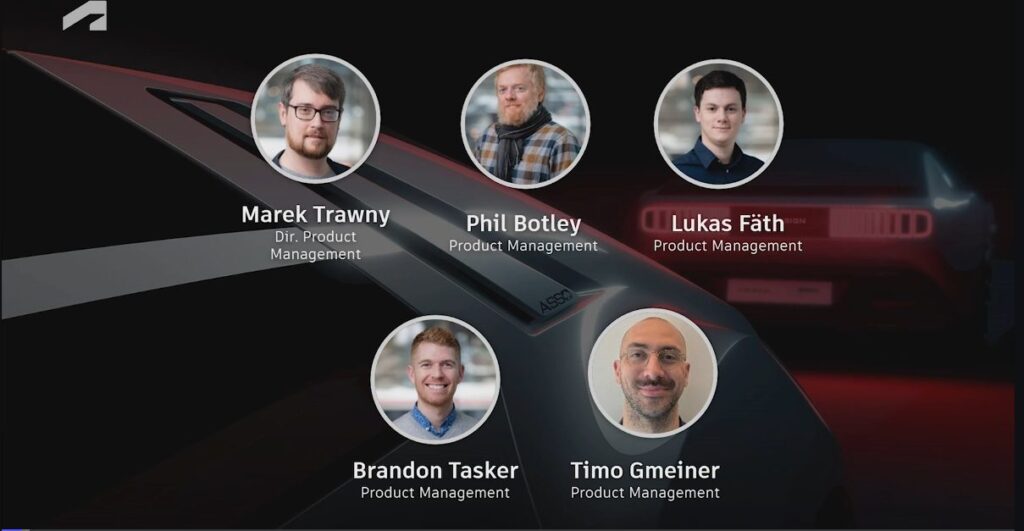
The 2024 AIF Design Studio keynote was our chance to share with you, our customers and users, what we’re excited about, what’s new, and what’s in development at the 2024 Automotive Innovation Forum.
The Product Management team discussed people and workflows, project management, collaboration, managing data, and more.
Watch the full keynote here — and take a look at some of the highlights below.
Marek Trawny — Autodesk today, tomorrow, and beyond
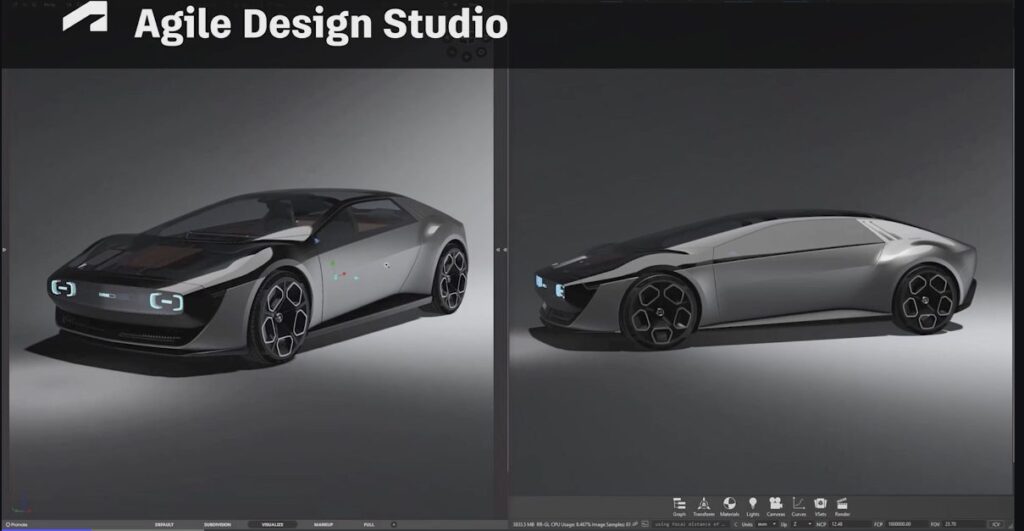
Our Director of Product Management, Marek Trawny, covered the essentials of Autodesk’s collaboration with customers, noting that many have been using some of our solutions for over two decades to create the most exciting automotive design and visualization products on the planet.
Autodesk’s goal is to give designers and teams the tools to do their job the best they can and to empower creatives to imagine and realize the most amazing designs. A big part of this is workflow – and last year, the team talked about the “perfect workflow.” While this varies from person to person, company to company, there are common, crucial elements: the perfect workflow is faster, seamless, more efficient. Everything the Alias, VRED, and Flow Production teams are doing aims to meet this goal.
Philip Botley — Making tools easier to use
And that’s where Phil Botley took the stage to share some of the improvements and changes the team has been working on.
Because design work is essentially the combination of people and workflows, all improvements are geared to facilitate smoother interactions. That means making tools easier to use, embracing open standards, improving design communication and visualization.

When it comes to ease of use, Phil showcased the new onboarding experience, simple user experience, and more fluid interactions between Alias and VRED.

Phil also called out a series of standout features in Alias and VRED:
- Alias’s “Puck Menu,” which allows collaboration with customers and builds on UI enhancements, so that designers can develop the products faster
- Alias’s refined Mark-up tool, smoothing and predictive strokes, quickly annotates model and shares it with team and others
- VRED’s “view cube” and “navigation bar” updates for a consistent look and feel
- VRED workspaces allow for more alignment with Alias
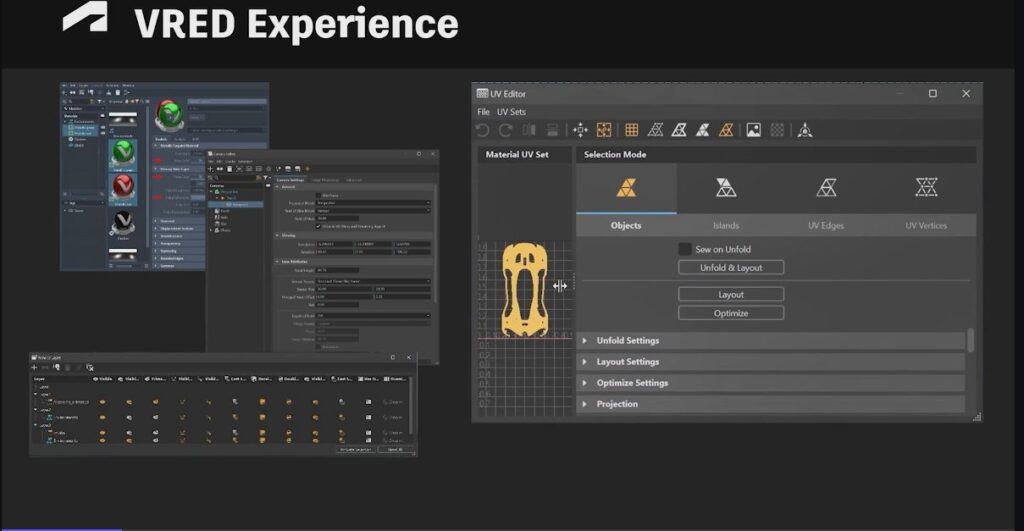
All of these refinements are designed to improve speed in workflows, so that designers can move seamlessly from ideation to concept into Class A release and future modeling and visualizations.
Brandon Tasker — Managing projects and teams
Another key element in the Autodesk solutions is how you manage your projects and teams.
Brandon Tasker took us through how ShotGrid is a big part of that story. It ensures you can manage all your projects, have visibility when you need it, and ensure everyone is working on the right thing at the right time.

Even more importantly, ShotGrid allows you to manage and share a large volume of data, so you can collaborate across design studios and across the world.
An update: ShotGrid has been rebranded to Flow Production Tracking, but nothing has changed in the program. The name change reflects the goal of reconnecting the products we have today to the future Solutions and Workflows.
Some key components:
- Generative scheduling, which helps you create and update schedules
- Multiple scenarios for different design processes in your studio
- Open Standards – Material X, Python, Open XR, USD (2025, Alias and VRED support USD), connecting you to the ecosystem
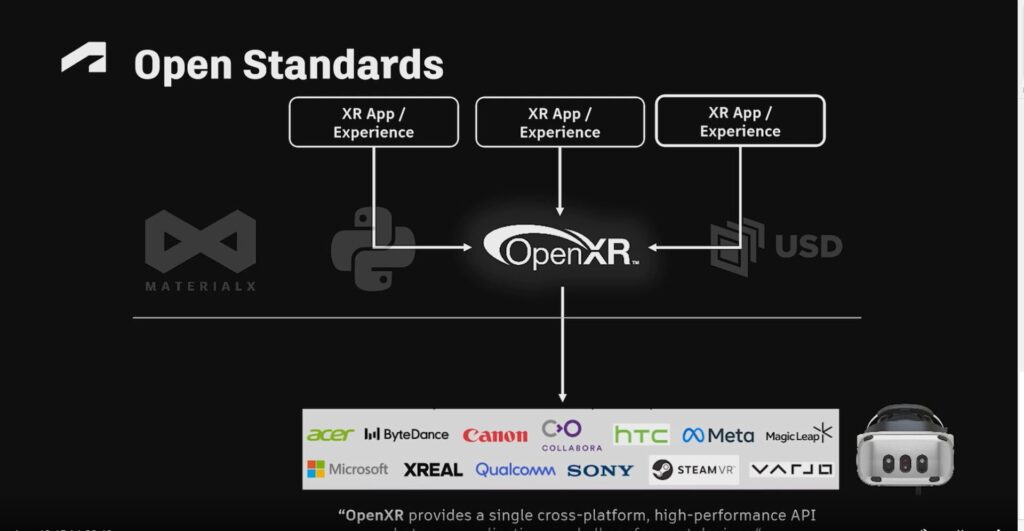
The PDM Connection allows for a seamless connection with engineering and increased trust in your data. All of this helps you and your project move through the process faster, which in turn reduces time to market.
Lukas Fäth – Increased opportunities for collaboration
Lukas Fäth was up next to talk about collaboration between Autodesk applications, as well as out-of-the-box, built-in collaboration capabilities.
We know design studios are changing, which increases the need for improved streaming capabilities and in-build web applications. Our team has been working hard to ensure design teams can collaborate anywhere, anytime, regardless of skill set, hardware, location, expertise.

Part of that is democratizing visualization, which means that anyone on a design team has seamless access to digital data sets – without needing to be an expert in that area.
It’s been rewarding to see where users have taken these new toolkits, using them to bring in new teams into collaborative, digital environments. This is what a tailored experience looks like.
Lukas notes that Autodesk is going further to enable true Enterprise-wide collaboration, drawing in a key area that has been previous isolate: marketing and sales.
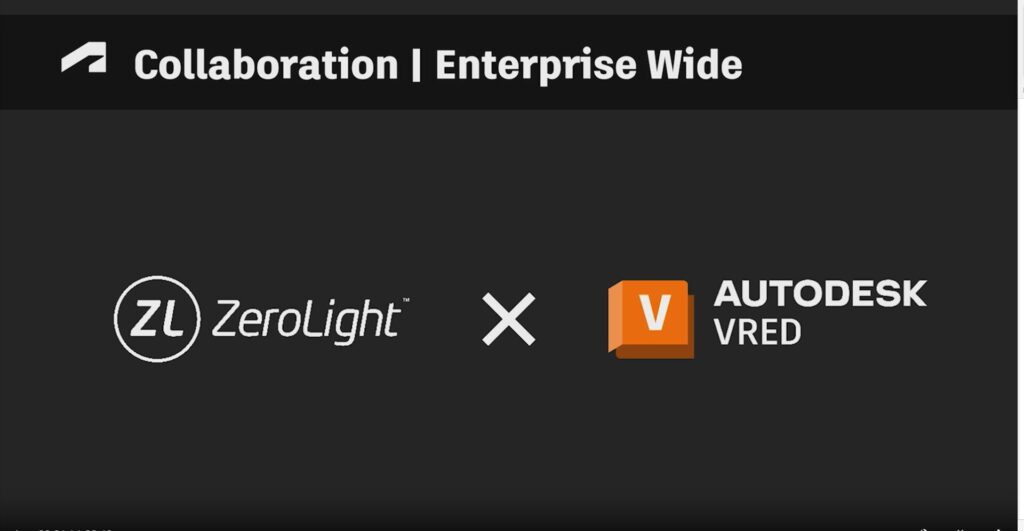
Autodesk is collaborating with ZeroLight, who built the first Cloud-stream car configurator for Audi six years ago. This collaboration combines ZeroLight’s expertise in streaming and experience around the customer journey with VRED’s high visual fidelity and data process.
Some key outcomes:
- Allows all of you to take VRED content beyond the studio
- Opportunity to collaborate better, bringing design, engineering, and marketing closer together
- Collaborate with your point-of-sale customers in shared online sessions
- Bringing physical and digital closer together, which reduces the need for physical prototypes
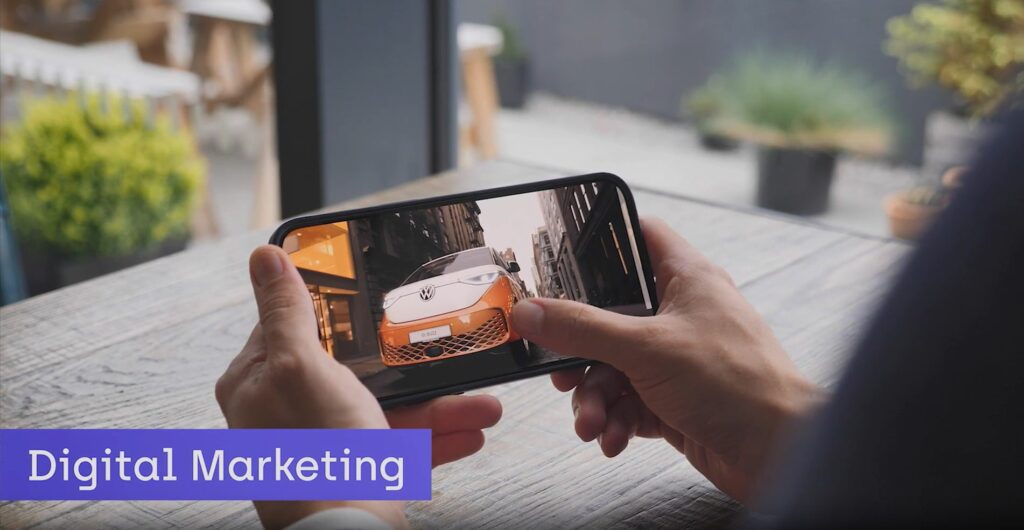
Our goal is always to provide you with the right tools to do the job. We know there’s a big focus on digital modelling right now, but there are also good reasons to create physical models.
We don’t believe you have to choose one or the other, that you can pick the right tool at the right time, and you can also combine them to get the best of both worlds.
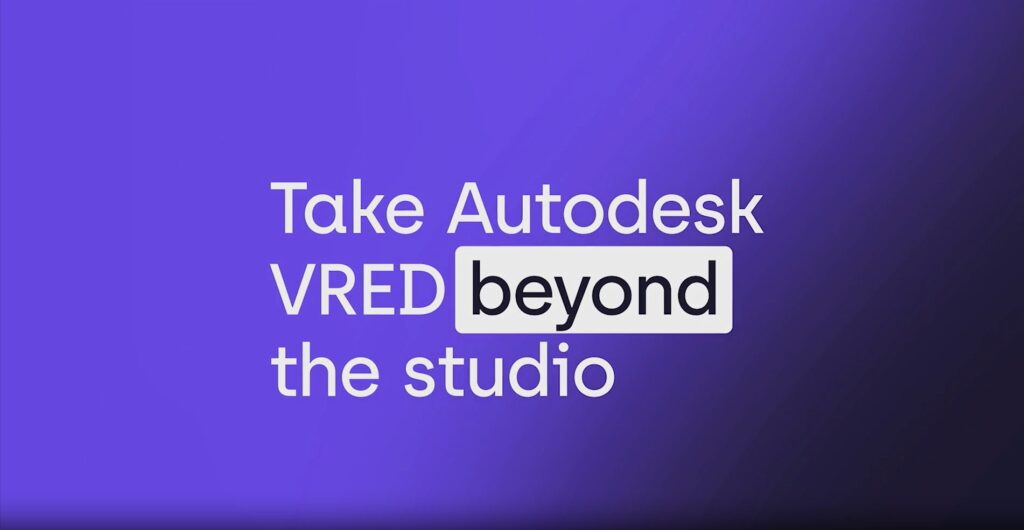
A few other highlights:
- Reviewing and showcasing digital prototypes
- VRED 2025 collaborating with UltraSpheres to offer high-quality HDRIs
- Importance of communicating emotional intent
- Volume Rendering updates in VRED 2025 – more lifelike and emotional imagery in real-time and offline
Lukas also touched on Modern and functional Digital Twins – where the importance of accurate review is key. You have to trust what you see on screen in order to make crucial decisions about CMF.

One of the most exciting updates is elevating how designers can tell the story of a car in motion. This modernization of main viewport technology means an enhancement of VRED’s animation capabilities.
Brandon Tasker — Seamless data flow between Alias and VRED
This recent development work now has real, working prototypes to support more fluid and accurate sharing of data between Alias and VRED.
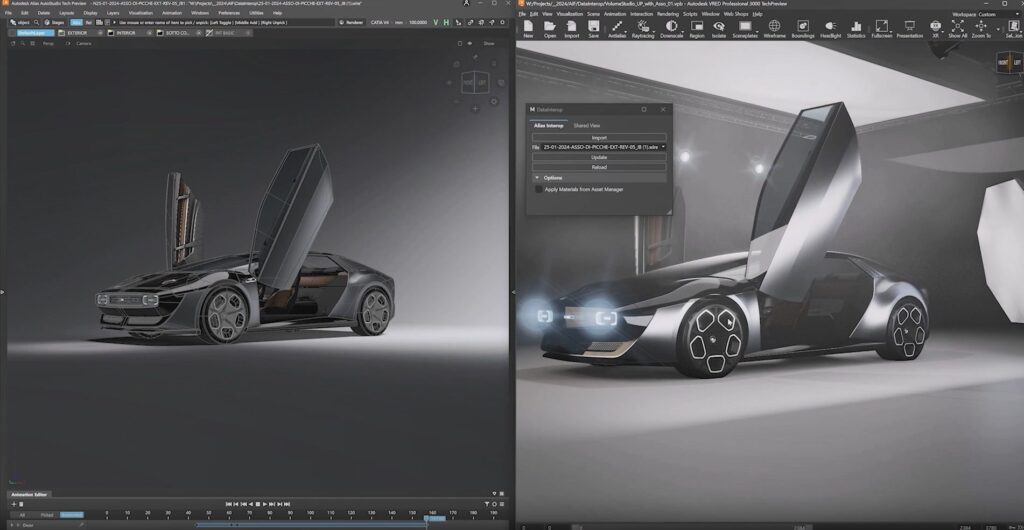
Called “Data Interop,” this prototype helps Alias and VRED users work fluidly together. How? An Alias model can be pulled quickly into a VRED scene – and where it used to take between 14-30 mins, it now takes seconds.
Data Interop means easier workflows that support instant updates. If changes are made in Alias, they can be pulled in almost instantly to VRED. Similarly, a Digital Sculptor can now pull a model into VRED for design review on a power wall or in VR/XR.
Data Interop is bi-directional, so it allows you to move back from VRED into Alias. Your Alias model will always be up-to-date with the current look and feel, which allows for more context in design reviews.

Design Annotations are a key part of any design process, and you can now pull them from VRED into Alias.
When it comes to lighting design, you can make detailed surface changes while leveraging VRED’s powerful raytracing technology. You will always know the effects you’re having on the model and how they look in Raytracing.
Data Interop also allows for a better hand-off in visualization. Designers don’t need to reload or rebuild entire scenes, because the scene can be set once even as the model evolves over time.
We’re really excited about the possibilities this seamless passing of data back and forth between applications offers designers.
Philip Botley — CFD
Optimization and improvement were the central threads in this Agile Design Studio keynote. Phil Botley returned to the stage to talk about how designers are using AI to predict and optimize and improve CFD.
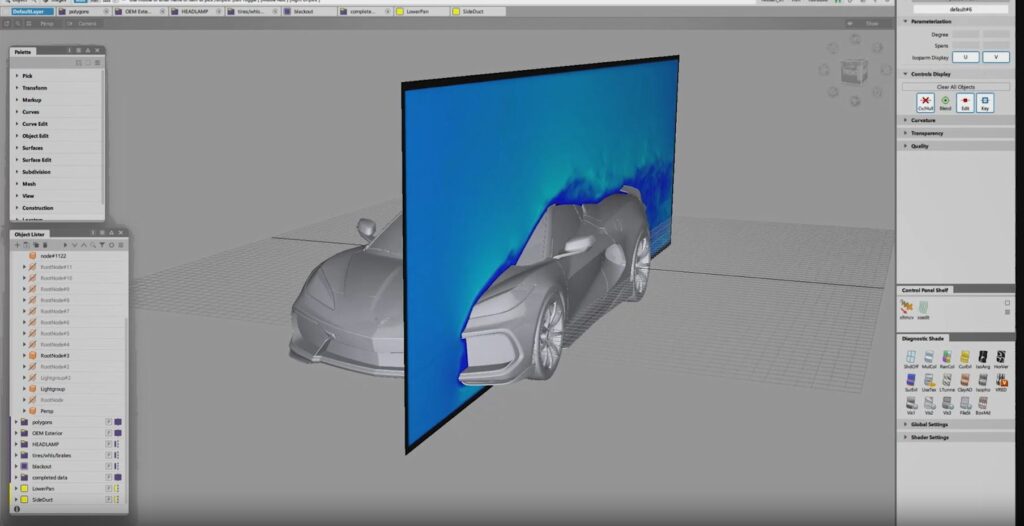
Take the Studio Wind Tunnel project, which integrated AI within Alias. Collaborating with Navasto, Autodesk is exploring how this integration can impact future ways of modelling.
Some key learnings from the project:
- Using the Feature Libraries to store node-based visualization graphs
- These libraries organize and house components, geometry, power-copy features
- They can be shared with both design and surfacing teams
Timo Gmeiner — Designing with AI support
AI / Machine Learning is top of mind for most industries right now, and the automotive design industry is no different. Timo Gmeiner talked us through what applying AI to automotive design challenges actually looks like.
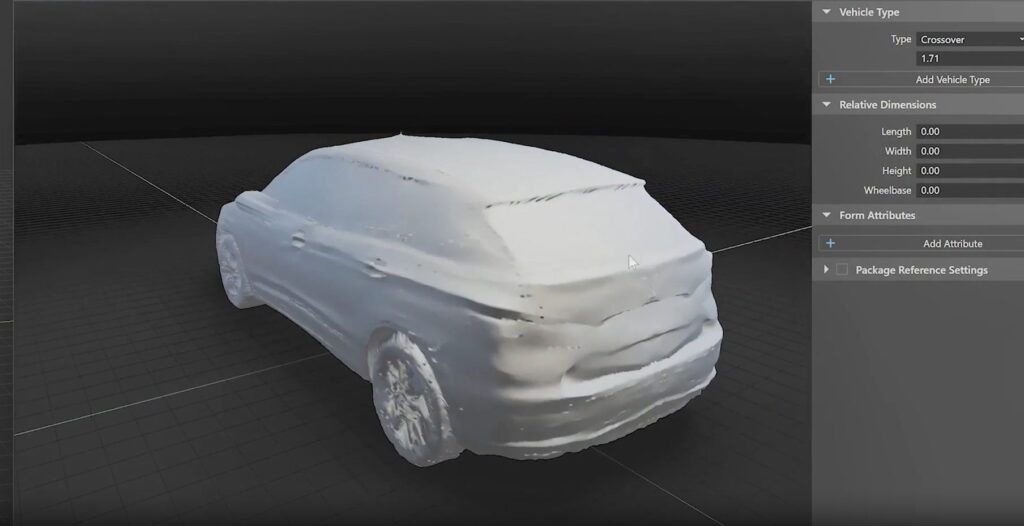
Using Form Explorer, an Alias Plug-in, you can generate and edit 3D concepts to quickly turn them into functional SubD models. There are two pathways for this AI support – using descriptive prompts or building “design recipes.” Either allows you to continue with SubD modeling with one click into Alias.
AI support allows you to build and explore more concepts quickly and streamline collaboration. Three core technologies power our AI integration: BlankAI + ReForm + Autodesk Cloud.
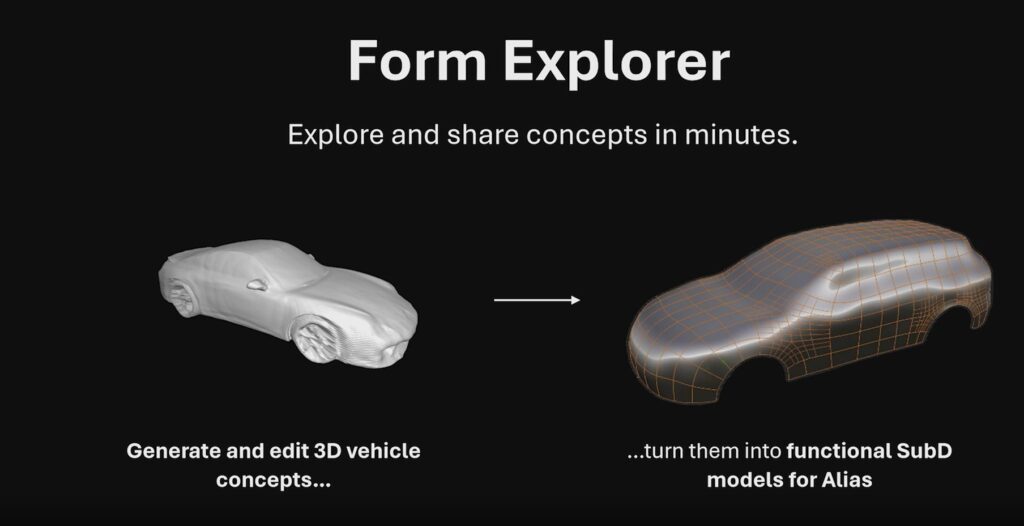
Unlike other AI engines, this trio uses selective training samples – thousands rather than hundreds of thousands, which makes output easier to control.
We continue to work on building trust in our AI offering.
Kia & Autodesk project
Voho Seo from KIA Motors and Yee Wang from Autodesk research used Generative AI to streamline concept wheel design. Working on the principle of “observations, not assumptions” the designers and researchers worked together to explore what are meaningful interactions for generative conceptual modelling.

Stay tuned for more content over the coming weeks, including customer spotlights, industry stories, and product updates.
You can also check out our Autodesk Automotive on LinkedIn, subscribe to our Alias and VRED YouTube channels, and follow us on Facebook.
If you’re not already an Alias or VRED user or would like to expand your skills at home, get started by downloading the Alias & VRED 2024 Learning Editions:
For Alias Learning Edition, click here.
For VRED Learning Edition, click here.